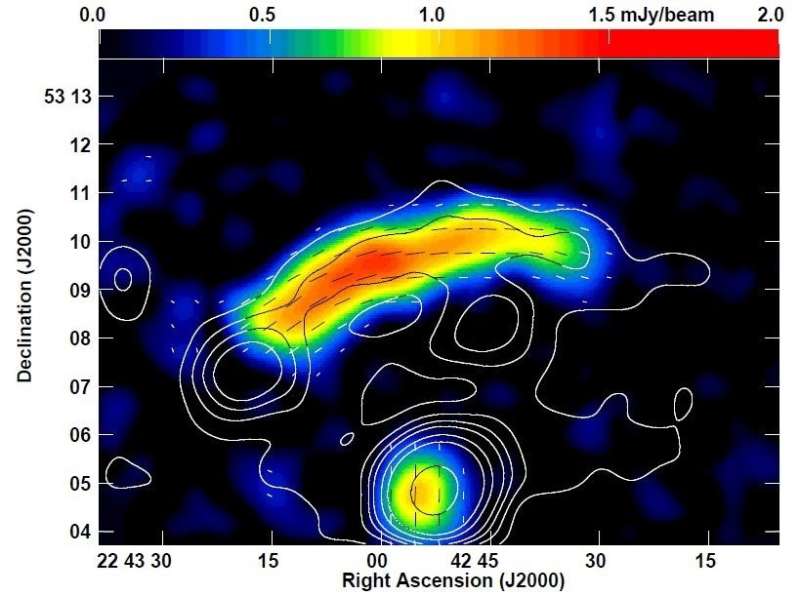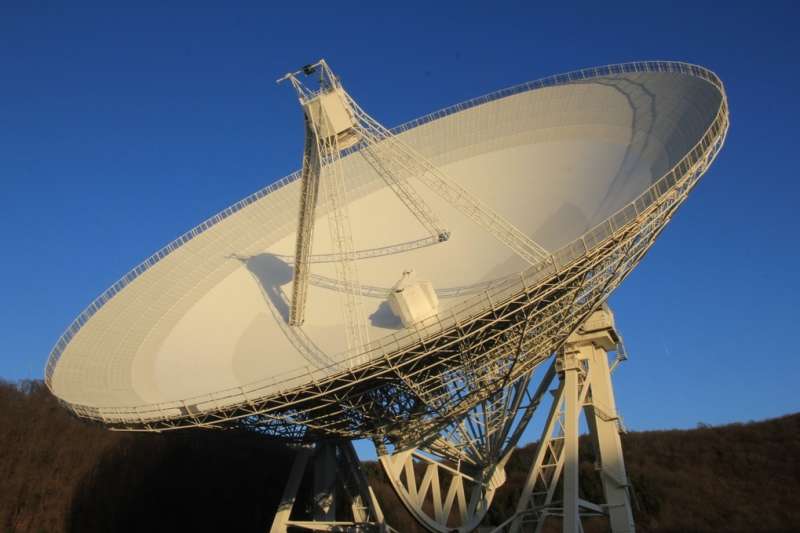Giant magnetic fields in the universe

Astronomers from Bonn and Tautenburg in Thuringia (Germany) used the 100-m radio telescope at Effelsberg to observe several galaxy clusters. At the edges of these large accumulations of dark matter, stellar systems (galaxies), hot gas, and charged particles, they found magnetic fields that are exceptionally ordered over distances of many million light years. This makes them the most extended magnetic fields in the universe known so far.
The results will be published on March 22 in the journal Astronomy & Astrophysics.
Galaxy clusters are the largest gravitationally bound structures in the universe. With a typical extent of about 10 million light years, i.e. 100 times the diameter of the Milky Way, they host a large number of such stellar systems, along with hot gas, magnetic fields, charged particles, embedded in large haloes of dark matter, the composition of which is unknown. Collision of galaxy clusters leads to a shock compression of the hot cluster gas and of the magnetic fields. The resulting arc-like features are called "relics" and stand out by their radio and X-ray emission. Since their discovery in 1970 with a radio telescope near Cambridge/UK, relics were found in about 70 galaxy clusters so far, but many more are likely to exist. They are messengers of huge gas flows that continuously shape the structure of the universe.
Radio waves are excellent tracers of relics. The compression of magnetic fields orders the field lines, which also affects the emitted radio waves. More precisely, the emission becomes linearly polarized. This effect was detected in four galaxy clusters by a team of researchers at the Max Planck Institute for Radio Astronomy in Bonn (MPIfR), the Argelander Institute for Radio Astronomy at the University of Bonn (AIfA), the Thuringia State Observatory at Tautenburg (TLS), and colleagues in Cambridge/USA. They used the MPIfR's 100-m radio telescope near Bad Münstereifel-Effelsberg in the Eifel hills at wavelengths of 3 cm and 6 cm. Such short wavelengths are advantageous because the polarized emission is not diminished when passing through the galaxy cluster and our Milky Way. Fig.1 shows the most spectacular case.

Linearly polarized relics were found in the four galaxy clusters observed, in one case for the first time. The magnetic fields are of similar strength as in our Milky Way, while the measured degrees of polarization of up to 50% are exceptionally high, indicating that the emission originates in an extremely ordered magnetic field. "We discovered the so far largest ordered magnetic fields in the universe, extending over 5-6 million light years", says Maja Kierdorf from MPIfR Bonn, the project leader and first author of the publication. She also wrote her Master Thesis at Bonn University on this subject. For this project, co-author Matthias Hoeft from TLS Tautenburg developed a method that permits to determine the "Mach number", i.e. the ratio of the relative velocity between the colliding gas clouds and the local sound speed, using the observed degree of polarization. The resulting Mach numbers of about two tell us that the galaxy clusters collide with velocities of about 2000 km/s, which is faster than previously derived from measurements of the X-ray emission.
The new Effelsberg telescope observations show that the polarization plane of the radio emission from the relics turns with wavelength. This "Faraday rotation effect", named after the English physicist Michael Faraday, indicates that ordered magnetic fields also exist between the clusters and, together with hot gas, cause the rotation of the polarization plane. Such magnetic fields may be even larger than the clusters themselves.
"The Effelsberg radio telescope proved again to be an ideal instrument to detect magnetic fields in the universe", emphasizes co-author Rainer Beck from MPIfR who works on this topic for more than 40 years. "Now we can systematically search for ordered magnetic fields in galaxy clusters using polarized radio waves."
More information: M. Kierdorf et al. Relics in galaxy clusters at high radio frequencies, Astronomy & Astrophysics (2017). DOI: 10.1051/0004-6361/201629570 , On Arxiv: arxiv.org/abs/1612.01764
Journal information: Astronomy & Astrophysics
Provided by Max Planck Society


















